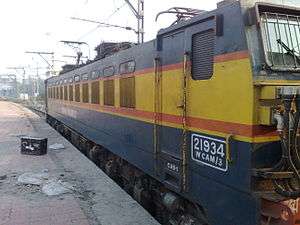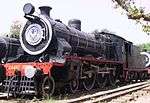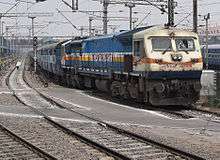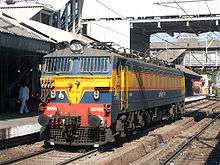Indian locomotive class WCAM 3
 | |||||||||||
| |||||||||||
| |||||||||||
| |||||||||||
| |||||||||||
WCAM 3 is a class of locomotives used in the Indian Railways system. They are the third of the WCAM series. They were specifically designed for use by Central Railways in the Ghat section towards Pune. They usually work on Mumbai CST - Igatpuri - Itarsi or Mumbai CST - Pune but not beyond that because of the unavailability of maintenance facilities.
The WCAM 3 class locomotives are in service in the Mumbai region’s Central Railway zone. The dual-voltage WCAM series locomotives haul intercity trains out of Mumbai DC suburban region on Central Railways which is on a 1500V DC overhead system, as opposed to other parts of India which have 25000 V AC overhead.
With Central Railways progressively moving towards a complete changeover from DC to AC traction, trains leaving Lokmanya Tilak Terminus have started using pure AC engines although WCAM engines still serve trains operating out of Lokmanya Tilak Terminus.
These upgraded dual-traction models deliver 4600 hp in DC mode and 5000 hp in AC mode, and were jointly developed by RDSO and BHEL in 1997. Components are shared with the WCAG-1 locos (see below). Co-Co fabricated bogies (High-Adhesion—shared with WCAG-1, WAG-7, WDG-2, etc.) with secondary suspension. Monocoque underframe. Air brakes are original equipment. They were originally manufactured under a BOLT (build-own-lease-transfer) contract with BHEL, and are probably still owned by BHEL rather than by IR.
Monocoque underframe. Axle-hung, nose-suspended, force ventilated, taper roller bearings Speed control by tap changers in AC mode and resistance notching in DC mode. Motors can be placed in different series-parallel combinations. Auxiliaries from Elgi, S F India, Best, Gresham & Craven, etc. Static converter from ACEC for auxiliary supply.
In DC mode, rheostatic braking by self-excitation of traction motors available until 17 km/h. Elgi compressor, other auxiliaries from S F India. Rated for 105 km/h in DC mode ( AC mode rated speed is quoted at 120 km/h). Traction motor configurations as in the WCAM-1/2 and WAM-4 (all 6 in series, 2S 3P, or all parallel—the latter is the only one used under AC traction, enforced now by modifications to the locos).
CR uses WCAM-3 locos on Mumbai-Pune and Mumbai-Igatpuri sections which have ghat portions as well as speed restrictions of about 100 km/h. Freight rakes double-headed by WCAM-3 (upgraded models) have been sighted on the ghat sections.
A WCAM3 #21946 was successfully converted to pure AC by ELW Bhusawal and its specifications match to WAG 7 class with traction motors in 6P configuration, is now being used as banker in Thull Ghat.
MU operation possible with 3 (4?) units.
As of [12/05], all WCAM-3 locos had been retrofitted with roof-mounted rheostatic braking grids.
| Class | WCAM–3 |
|---|---|
| Year | 1997+ |
| Maker | BHEL |
| Traction Motors | Hitachi HS15250A. Axle-hung, nose-suspended, force-ventilated. |
| Transformer | BHEL 5400 kVA. 32 taps |
| Power(hp) | 4600 DC / 5000 AC cont. |
| Rectifiers | Two silicon rectifier units D1800N44 (Siemens), 16 cells per bridge. 1000V / 3600A. |
| Speed | 105 DC / 120 AC |
| Weight(tonnes) | 113 |
| Quantity | 53 |
| Serial nos | 21881-900 /21931-963 |
Loco sheds holding WCAM 3 engines
The only shed to ever hold WCAM 3 engines is Kalyan.
Trains Hauled by WCAM-3
The WCAM 3 locomotives haul the trains Deccan Queen, Tapovan Express, Panchvati Express, Mahalaxmi Express, Pune Nagpur Express among others.
See also
- Indian Railways
- History of rail transport in India
- Locomotives of India
- Rail transport in India
- Central Railway zone
- WCAM 2/2P
| Wikimedia Commons has media related to Indian locomotive class WCAM-3. |
External links
- http://www.irfca.org/gallery/Events/cracdcjan13/
- http://www.irfca.org/faq/faq-loco-electric-dc.html#acdc




